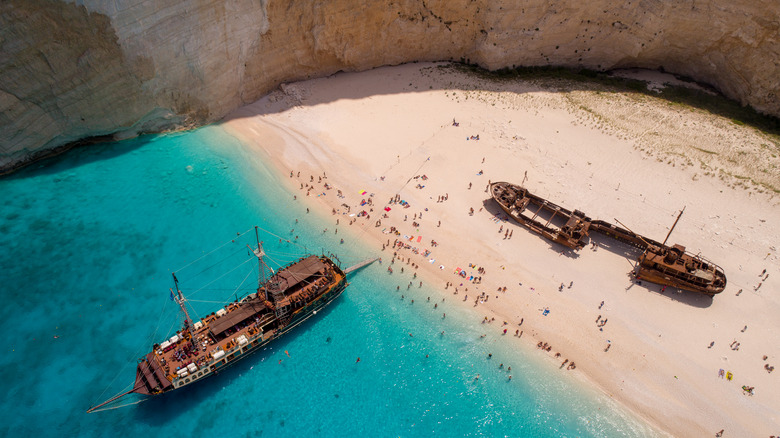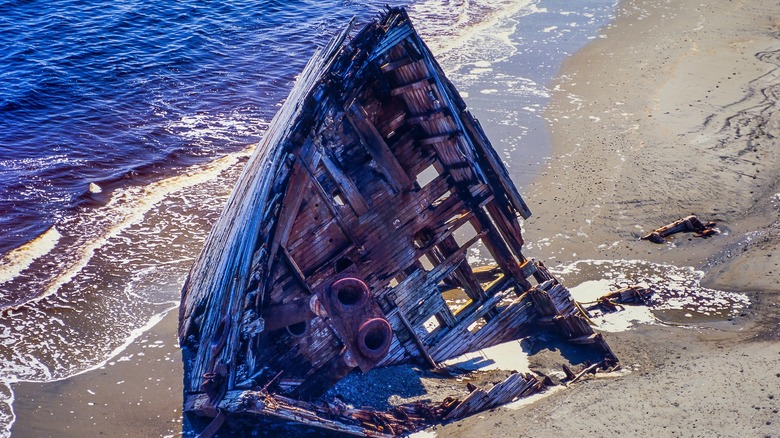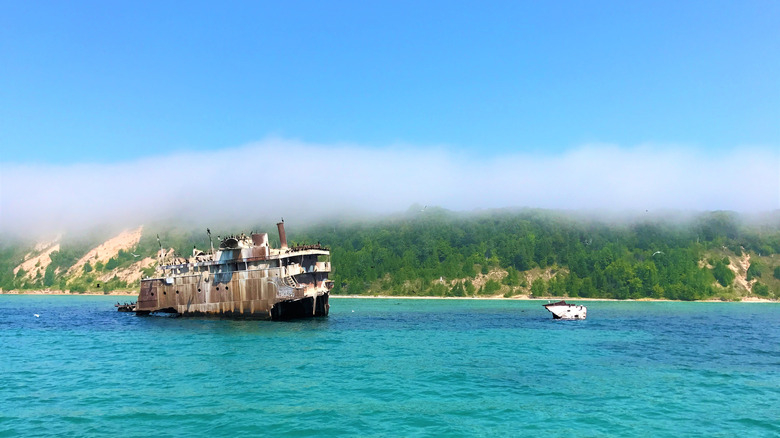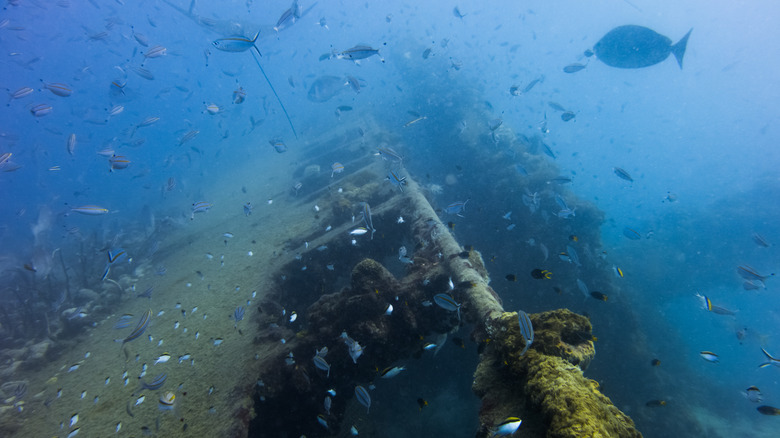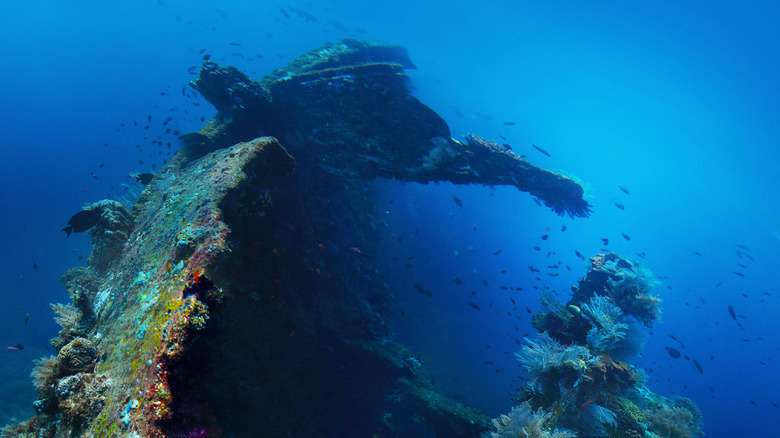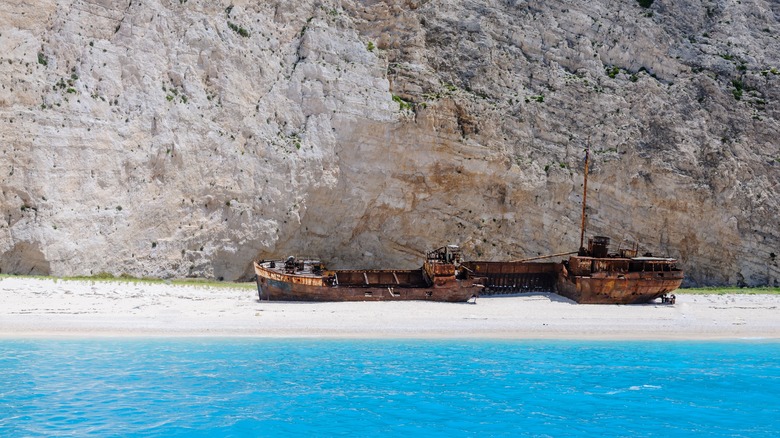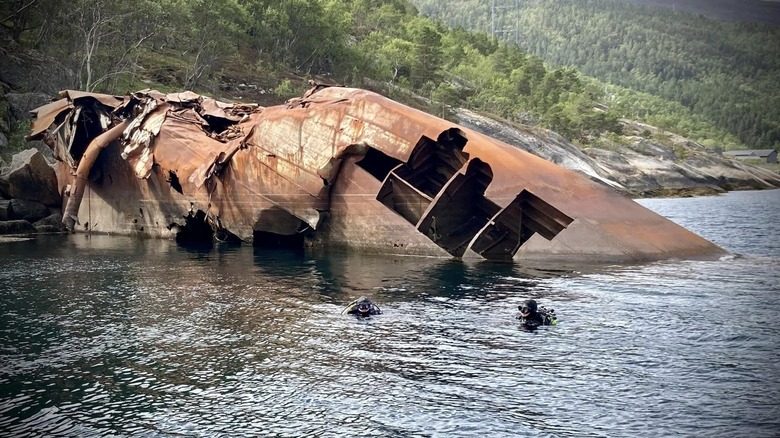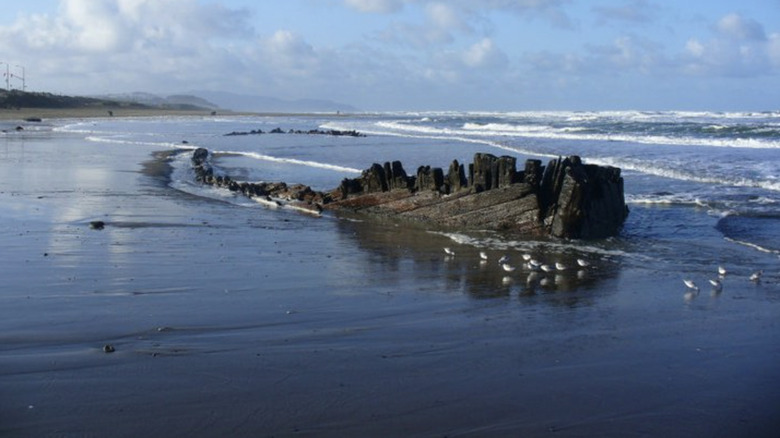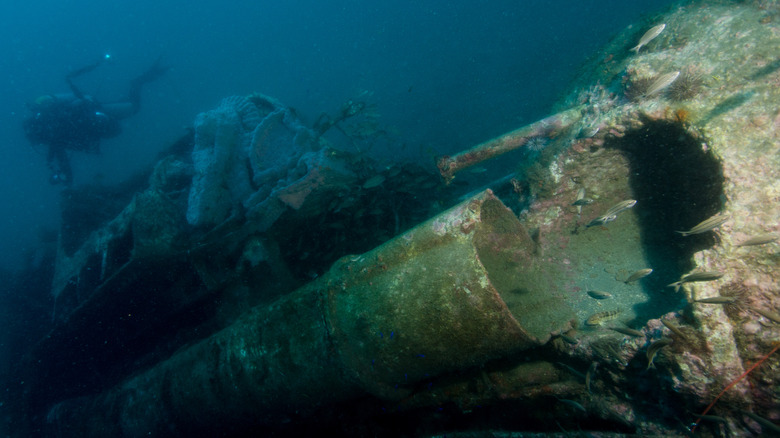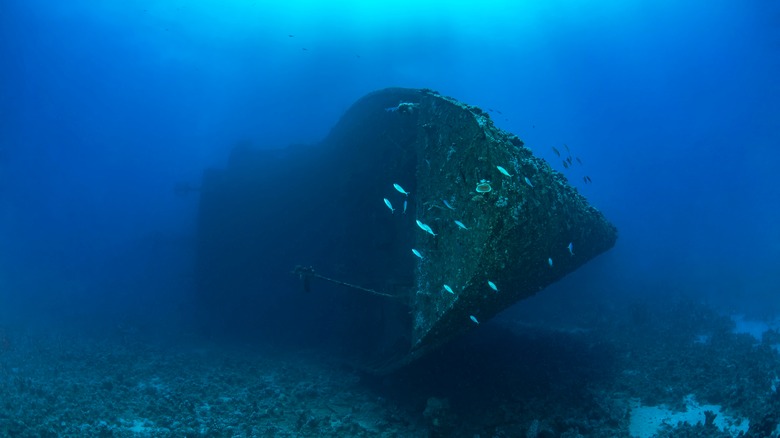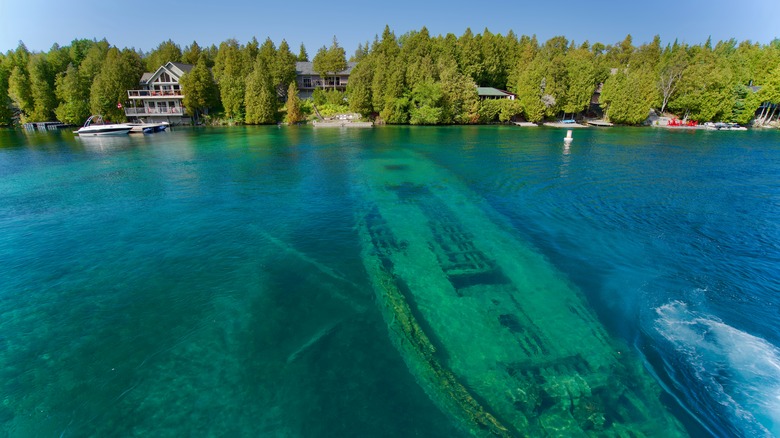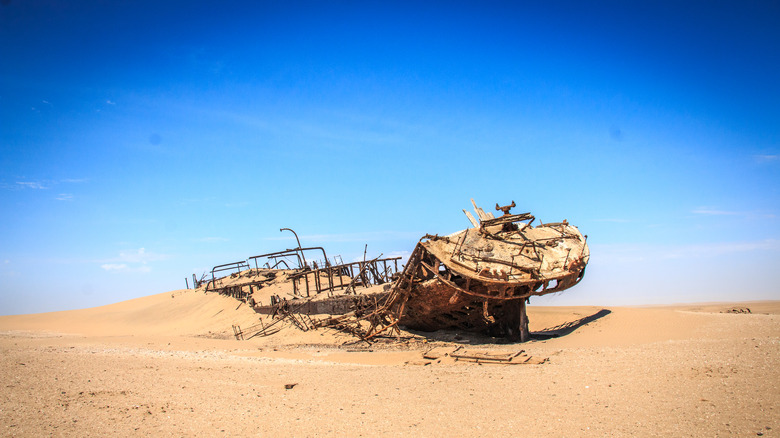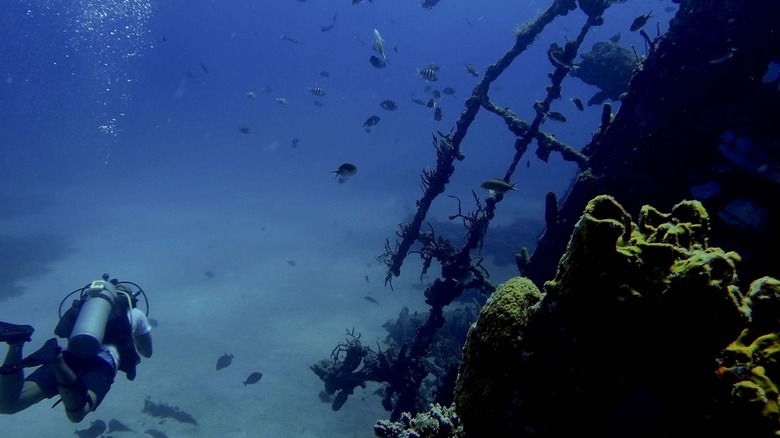12 Haunting Shipwrecks Around The World You Can Visit
For as long as humans have roamed the earth, the ocean has brought commerce, sustenance, adventure, hope — and plenty of peril. According to UNESCO, more than 3 million shipwrecks are scattered around the globe, with just a tiny sliver of those having actually been explored (and many of them were discovered accidentally).
Many of these shipwrecks resulted from terrible luck, be it from weather, mechanical failure, or war, leading to many deaths. Many ships have been deliberately sunk, either to prevent a vessel from falling into the hands of another party or to create artificial reefs to help marine ecosystems flourish. But so many rusted, decayed shipwrecks — which at one time or another may have symbolized hope, riches, or survival (or doom) — have a haunting, eerie quality to them, whether tragically lost or purposely sunk. Either way, they sit on ocean or lake floors or sandbars, letting the elements and time do with them what they may. Still, shipwrecks are fascinating, and there are many accessible wrecks around the world waiting to be explored.
The Pesuta Shipwreck, Tlell, British Columbia, Canada
On British Columbia's northwest coast, at the mouth of the Tlell River, sits the fascinating Pesuta shipwreck, its hull jutting out from the river bank. In December 1928, the log-carrier was being towed through the Hecate Strait. Amid a treacherous winter storm, the tugboat's towline snapped, and the Pesuta ran aground on the river bank. No one was injured, but the ship was unrecoverable. Its cargo was removed, and the ship stripped of valuable material, then left to the elements. A weathered hull and rusted metal portholes are all that remain.
Even without any loss of life, the Pesuta has an eerie quality. Contrasted with the unspoiled beauty of this remote area, its potential for danger stands out. The Pesuta shipwreck sits in Naikoon Provincial Park, accessible via an eight-hour ferry ride from Prince Rupert to Graham Island, part of the Haida Gwaii archipelago. A daily, two-hour flight from Vancouver to nearby Sandspit is also available. On the island, access the park at the Masset (north) or Tlell (south) entrance. Start at the Tlell River Day Center and follow the Pesuta Shipwreck Trail, a three-hour round-trip hike on mostly flat trails. BC Parks advises hiking at low tide — high tide can be dangerous.
The Pesuta was originally a wood-hulled steam freighter built in Washington State as part of the U.S. World War I shipbuilding effort. Post-war, it became a log-carrier, measuring 264 feet long and capable of hauling 800,000 feet of logs.
SS Francisco Morazan, South Manitou Island Shoal, Traverse City, Michigan
The cargo ship SS Francisco Morazan ran aground in a fall storm 300 feet from shore on South Manitou Island along Michigan's Sleeping Bear Dunes National Lakeshore in November 1960. The ship's captain and crew battled rough surf that sent waves crashing over its decks, along with 40 mph winds, thick fog, and heavy snow, before beaching on a shoal. The Morazan had left Chicago for Europe, racing to exit the St. Lawrence Seaway before navigation season closed. Needless to say, the Morazan quite didn't make it.
To add insult to injury, the Morazan ran aground over another shipwreck, the Walter Frost, which sank on the same spot 57 years earlier. Both the Morazan and the Frost are accessible to divers in 20 feet of water in Lake Michigan, excellent for novice divers. To visit, drive 35 minutes north from Traverse City, Michigan, to Leland, and take an hour and a half ferry ride to South Manitou Island. Then, it's a 2-mile hike to the wrecks, with viewing platforms on shore.
At 12 feet, the Morazan's remaining hull and boiler are visible. Everyone on the Morazan survived, and the captain's pregnant wife had to be airlifted off the ship by the Coast Guard before the crew abandoned ship. The SS Francisco Morazan was built in Germany in 1920. It served the Axis during World War II before the British Navy seized it and put it to work for the Allies.
SS Yongala, Cape Bowling Green, Queensland, Australia
Referred to as the "Aussie Titanic," the SS Yongala, a 357-foot-long steamship, went down in a cyclone off Cape Bowling Green in 1911. The wreck is the final resting place of 122 doomed souls. The wreck was discovered by local divers more than 50 years after it sank — before that, its final resting place was unknown. No human remains were ever recovered. The body of Moonshine — a prized racehorse that was onboard — washed ashore a few days after the Yongala was lost.
After human remains were discovered inside the Yongala's hull in 1994, Australia passed a law barring divers from entering the wreck, considering it a gravesite. Still, divers can explore around the wreck, which sits in the Coral Sea off Australia's East Coast. Divers must be Open Water certified (requires 15 dives) to visit the Yongala alone or have six dives to their credit to dive with a guide. The Yongala is one of the best preserved and popular dive spots on earth, with reputable outfits taking divers to the wreck.
The Yongala remains one of Australia's worst peacetime maritime disasters. But the wreck sits in the magnificent Great Barrier Reef, home to an amazing array of marine life. Divers will see some of the 122 species known to frequent the site, including turtles, eagle rays, sharks, and tropical fish like groupers and clownfish.
USAT Liberty, Bali, Indonesia
The Japanese Navy torpedoed the USAT Liberty, a U.S. Army cargo ship, in January 1942, southeast of Bali. Miraculously, the Liberty didn't sink, and its crew survived. Attempts to tow the ship to harbor failed, so the Liberty was beached on Tulamben, near Bali. Then, the Liberty was left to rust into oblivion for over 20 years. After a nearby volcanic eruption in 1963, tremors caused the Liberty to slide into the water to its current resting place, an accessible diving and snorkeling location within a quick walk of the beach.
Sitting in between 9 and 100 feet of water and just 20 minutes from popular tourist spot Abed, the U.S. Army's loss is divers' gain. The Liberty is one of the most popular dive spots in the world, best visited during the rainy (low) season, from December through April, when it is less crowded. This is an excellent spot for novice and intermediate divers, with many underwater photo opportunities around and within the wreck. The bulk of the Liberty's body, lying on its starboard side, sits about 80 feet deep, where you'll see bulkheads, steel cables, ladders, and more. Go a bit deeper, and you'll see the Liberty's bow guns still on their mountings.
Coral isn't the only sea life you'll encounter. Lots of tropical fish live in and around the Liberty, from turtles, sting rays, electric clams, groupers, squid, and more. Keep your eyes out for sharks, too.
MV Panagiotis, Zakynthos Island, Greece
In 1980, the cargo ship MV Panagiotis ended up beached on what is now known as Shipwreck Beach (or Smugglers' Beach) on the Greek island of Zakynthos in the Ionian Sea. But how did the ship get there? The details remain murky. Rumor has it that, during a massive storm, the Greek Navy was in hot pursuit of the Panagiotis, allegedly full of contraband cigarettes, and headed for Italy. Apparently, the combination of bad weather and said naval chase led to the ship's grounding. The crew quickly dispersed and hid the cigarettes, only to sell them later on the bootleg market. Rumors persist the ship was used for human trafficking. But none of this has been confirmed — or debunked, for that matter.
Tall tale or harrowing true story, the MV Panagiotis remains on the beach more than 40 years later. It is a rusting, orange hulk sitting on a gorgeous, white sand beach in a beautiful bay, surrounded by 200-foot-high limestone cliffs on three sides. Zakynthos, a gorgeous and budget-friendly Greek island, can get busy during the high season from April through October. The island and the beach are only accessible by boat, but island tour operators go there often. There is also a photo platform 200 meters up the cliff, but be careful — at least two tourists have fallen to their deaths while attempting to take selfies.
Z2 Georg Thiele, Narvik, Norway
In May 1940, after being seriously damaged by Allied fire during the Battle of Narvik, the captain of the Z2 Georg Thiele beached the Nazi destroyer to save his remaining crew — 14 sailors had already been killed in the battle. After running aground, the Georg Thiele split in two. Its rusted-out hull is still visible on the Ofotfjord shoreline today.
Narvik is a port city in the Arctic Circle on Norway's northern coast. The rusted-out skeleton of the Georg Thiele is unique in Narvik in that it is accessible to both hikers and divers. It takes 30 minutes to hike to the Georg Thiele once in Narvik, an hour and a half flight from the capital, Oslo. The start of the path to the Georg Thiele begins behind the green building in the parking lot and follows from there. The path can be slippery and uneven, so be careful. To see the rest of the Georg Thiele, you'll have to dive. Dive Narvik is a reputable diving outfit taking divers to see the Georg Thiele wreck, and other ships sunk during the Norwegian Campaign.
More than 60 ships were sunk from April through June 1940 and lay at the bottom of the fjord, including about 45% of the Nazi Naval fleet, a stunning loss that infuriated Hitler. Both the Allies and the Axis coveted Narvik, as it was an ice-free harbor with access to Sweden's iron, a critical wartime resource.
The King Philip, Ocean Beach, San Francisco
The King Philip clipper, beached on San Francisco's Ocean Beach, is less a haunting shipwreck and more like the final chapter in a colorful and darkly comical history. In January 1878, the King Philip was being towed, with another boat, through the Golden Gate. When the captain of the second boat had the audacity to suddenly drop dead, the tugboat cut ties with the King Phillip to help the other boat. The King Philip dropped anchor, but the surf was too rough, and she was beached.
After the King Philip was stripped for all it was worth, the tides claimed its wooden outline, only revealing it again in 1902. The King Phillip remained underwater for 80 years until low tide unveiled the wreck again in 1982. Most of the ship is gone, but its wooden outline remains, jutting up from the sand. Visit Ocean Beach, an 8-minute walk southwest of Golden Gate Park, in the early morning at low tide to see it.
After the King Philip was beached, its owner decided to sell it for scrap. Taking the ship apart was a chore, so the owner tried blowing it up – failing on the first two attempts. Eventually, the ship was destroyed, delighting the gathered crowd and rendering its valuable timber and metal salvageable. The King Philip also survived two mutinies in its history, both times being set on fire.
U-352, Outer Banks, Morehead City, North Carolina
In May 1942, during the Battle of the Atlantic, German U-boat U-352 fired a torpedo at what it thought was a merchant ship off North Carolina but missed. It was no merchant ship, but the U.S. Coast Guard cutter "Icarus," which steamed towards the sub and dropped depth charges to destroy it. U-352 dove to the ocean floor, but at 95 feet, it was too shallow to avoid the explosives. The sub was severely damaged, and 15 sailors were killed. The captain ordered the sub to surface so the remaining crew could escape. Upon resurfacing, the remaining crew were taken prisoner, and U-352 sank to the ocean floor.
Divers found the wreck in 1975, now a popular diving spot in the Outer Banks (also home to some of the most beautiful coastlines around the world). U-352's hull is mostly gone, but the rest of the submarine is intact, listing at a 45-degree angle. The sub's interior is visible, but as a gravesite, it is illegal to enter. Olympus Dive, in Morehead City, is one of many reputable diving outlets to visit the site.
U-352 demonstrates how close German submarines were to North America during the war. Captured U-352 sailors admitted to liking American jazz, picked up on the sub's radio. During the war, U-boats sank hundreds of ships from Maine to Texas. German subs were even spotted deep into the St. Lawrence River, 170 miles from Quebec City.
Salem Express, Safaga, Egypt
The Salem Express was a passenger ferry sailing from Jeddah (Saudi Arabia) to Safaga (Egypt) in December of 1991 when it hit an unmapped reef amid gale-force winds, causing it to sink. At least 470 people died, many of them women and children. The Salem was piloted by an experienced captain, who was taking an unauthorized shortcut through the Red Sea's Hyndman Reefs to shave two hours off the trip. The Salem Express lies in just over 100 feet of water, and there are rumors the wreck is haunted.
Divers can explore around the wreck, and accredited diving outfits like CDWS can take you to where the Salem rests. The twin smokestacks and the Salem's propeller are easily seen and can be explored from the outside. Entering the Salem Express is forbidden by law, but that has not stopped some divers from doing so. Bags, suitcases, clothing, and children's toys litter parts of the ship. The Salem Express carried vehicles, too, which have been overtaken by sea life and coral. Divers who have illegally entered the site report an eerie energy within the Salem, with parts of it completely closed off to natural light, making it disorienting to even advanced divers. This wreck may indeed be haunted, but please remember — it is illegal to enter the Salem, no matter the behavior of other divers.
Sweepstakes, Bruce Peninsula, Ontario, Canada
In August 1885, the Sweepstakes, a Great Lakes schooner hauling coal through Georgian Bay, east of Lake Huron, hit a rock off Cove Island, leading it to be partially submerged. Towed into nearby Big Tub Harbor, the Sweepstakes was deemed beyond repair. After removing the coal and other salvageable material, the ship was allowed to sink, going fully under in September 1885. Today, the ship remains in the exact spot where it went down well over a century ago.
Submerged in just 20 feet of water, the Sweepstakes is a popular diving and snorkel spot and an excellent spot for novice divers to gain experience. Part of the stern deck has deteriorated, but most of the hull, centerboard, windlass, and deck can be explored. For both safety and preservation purposes, divers are not allowed to go inside the wreck or swim underneath it, as it is not safe. Access to the Sweepstakes wreck is controlled, so divers and snorkelers must register with Parks Canada first. The site can be explored from May through October.
The Sweepstakes wreck is one of the best-preserved 19th-century Great Lakes schooners and is remarkably well-preserved thanks to the Bruce Peninsula's clear waters and cold temperatures. A nearby wreck of an early 20th-century passenger liner, the City of Grand Rapids, is just 100 feet away and is also open for exploration.
The Eduard Bohlen, Skeleton Coast, Namibia
On a cargo run from Namibia's northwest coast to South Africa, the Eduard Bohlen didn't make it very far. It ran aground on a sandbar amid thick fog, 300 feet from shore, on September 5, 1909. No one died in the accident, but the Eduard Bohlen's rusting remains are now a haunting symbol of nature's triumph over human will. More than 100 years later, the Namibian desert has slowly encroached upon and partially subsumed the Bohlen. It now sits 1,000 feet from the waterline.
Visiting the Bohlen is not for the faint of heart, even if it is one of the most beautiful coastlines on the planet. It sits with other rusted husks on Skeleton Coast, now a national park known as one of the world's largest ship graveyards. The landscape is unforgiving, with scorching desert heat juxtaposed with wild surf. You can visit Skeleton Bay and the remnants of the Bohlen by trekking six hours west of Windhoek. Go by 4x4 with a guide, which can be arranged in Swakopmund, four hours from Skeleton Coast.
There is plenty of animal life here, such as elephants, hyenas, big cats, and a huge variety of birds. Nearby is Cape Cross, a world-renowned seal colony. In the past few decades, Skeleton Coast has developed a reputation as one of the world's last epic surfing spots. That said, Skeleton Coast is not for novices – hardcore surfers only.
The SS Antilla, Caribbean Sea, Aruba
The SS Antilla was a 400-foot, 5,000-ton German cargo ship scuttled off the Dutch territory of Aruba in 1940. The crew set the Antilla ablaze and started flooding it with seawater after learning Dutch Marines would seize the ship in the wake of Germany's invasion of the Netherlands. The Antilla's captain and crew were arrested and removed from the ship, which was then allowed to sink into the Caribbean.
The Antilla is the largest shipwreck in the Caribbean. It sits in 30 feet of water and is a popular diving and snorkel spot. Aruba is a beautiful, budget-friendly, warm-weather destination, and many Aruba tour operators bring tourists to explore this open water wreck. Even though the Antilla doesn't rest near a reef, the ship acts as one, flourishing with marine life. Whether diving or snorkeling, you're bound to see tropical fish, lobsters, octopus, and other creatures. Unlike many wrecks, divers are allowed to enter and explore the Antilla wreckage. Be mindful of any sharp edges, and never remove any items from the wreck.
There were rumors that the Antilla was an auxiliary ship for U-boats during World War II, but that has never been proven. The ship was searched multiple times by Dutch authorities for weapons and munitions before it was seized, but nothing was ever found.
